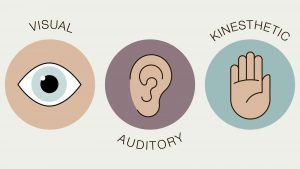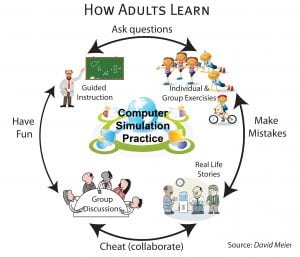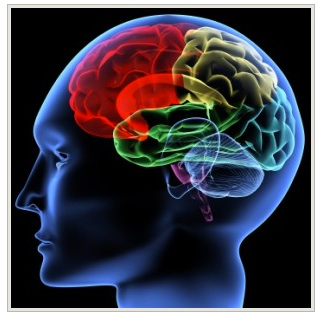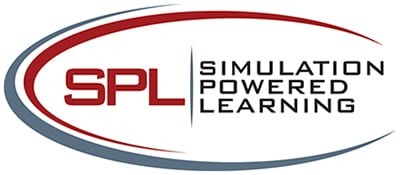Training Designed for Adult Learning
The learning advantage of Simulation Powered Learning goes beyond just our award winning simulation. Learning styles, adult learning concepts, team learning, and understanding how the brain works are all learning best practices integrated into Simulation Powered Learning.
Learning Styles – There are many different learning styles and combinations of learning styles. No styles are considered better or worse; they all work. Below are the three styles addressed in SPL:
- Visual learners are people who learn best by using their sense of sight. For visual learners SPL classes inc
 lude colorful materials, graphics in the materials and simulation, and multiple charts for planning and managing their simulation project hanging on the wall.
lude colorful materials, graphics in the materials and simulation, and multiple charts for planning and managing their simulation project hanging on the wall. - Auditory learners are people who learn best by hearing what they need to learn. For auditory learners SPL classes include interactive discussions, team exercises, and team discussions as they run the simulation and presentations.
- Kinesthetic learners are people who learn when they are able to physically move or touch the material that is being taught. For kinesthetic learners SPL classes include practical team exercises to create project management tools, planning and managing a real-life project with real life challenges, stakeholders and team members, and creating status and final reports.
Team Learning – Given the right environment and opportunity every student is more or less receptive to learning with and/or from other students. SPL classes are team based and offer multiple opportunities for team learning as teams plan and manage a simulated project as the Project Manager, Scrum Master, Leader or Business Analyst. In planning and managing their project the student teams must come to agreement on their decisions. In making these decisions the students influence and learn from each other as they:
- Discuss the situation and how best to respond
- Consider all options
- Question assumptions
- Postulate the results of each potential response
- Connect the results of their decisions
- Receive feedback that leads to understanding

 The David Meier adult learning model tells us that adults learn best when they are asking questions, making mistakes, collaborating, and having fun. In SPL classes our instructors use the Socratic approach, both asking questions and encouraging questions. While working in teams, students question each other. The simulations are designed such that mistakes are inevitable. Instructors don’t call them mistakes, they call them “management challenges you need to overcome” and encourage student teams to turn the mistake into a positive if possible. Teams learn from running their own simulation and from other teams who are running the same simulation while making different decisions and getting different results. The simulations are engaging and challenging and teams compete with each other to create a fun learning environment.
The David Meier adult learning model tells us that adults learn best when they are asking questions, making mistakes, collaborating, and having fun. In SPL classes our instructors use the Socratic approach, both asking questions and encouraging questions. While working in teams, students question each other. The simulations are designed such that mistakes are inevitable. Instructors don’t call them mistakes, they call them “management challenges you need to overcome” and encourage student teams to turn the mistake into a positive if possible. Teams learn from running their own simulation and from other teams who are running the same simulation while making different decisions and getting different results. The simulations are engaging and challenging and teams compete with each other to create a fun learning environment.
AGES – A four-part model for how to make learning stick:
- Attention – Students are focused on topic
- Generation – Occurs when the student is motivated to understand, conceptualize, retain, and apply the knowledge/skill in their own way, getting people to talk to each other about ideas (reflecting and thinking) vs. listening to presentations
- Emotion – Increases memory retention
- Spacing – Distributing learning over time leads to better long-term memory

SPL classes are designed to maximize learning based on the AGES model. The simulation focuses students on the learning objectives programmed into the simulation while engaging them a realistic and challenging project that raises their emotional levels. The simulation provides the required practice and team member interaction (reflection and thinking) to generate learning. Spacing for retention is achieved by mixing running the simulation with lectures and other classroom activities.
